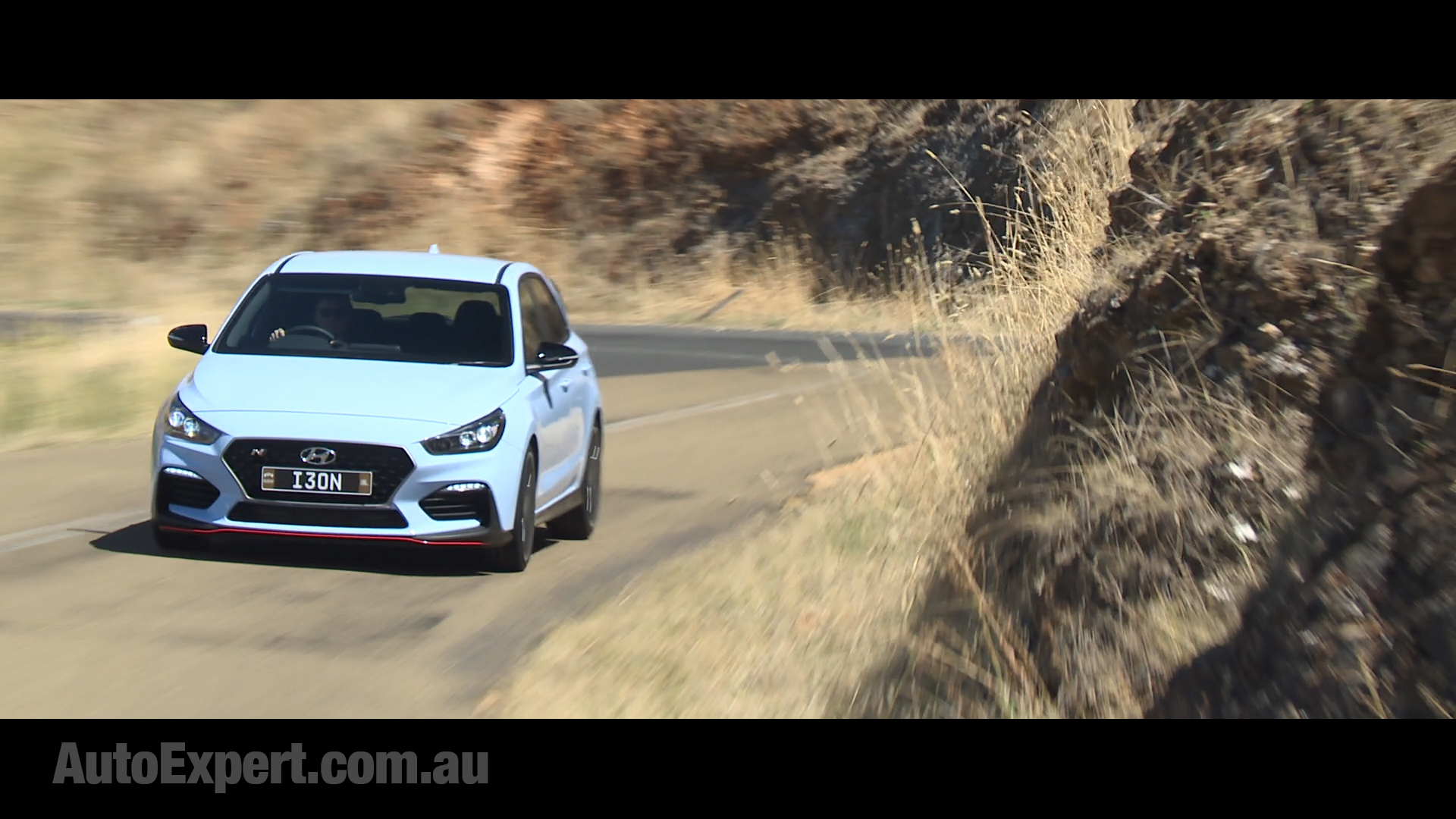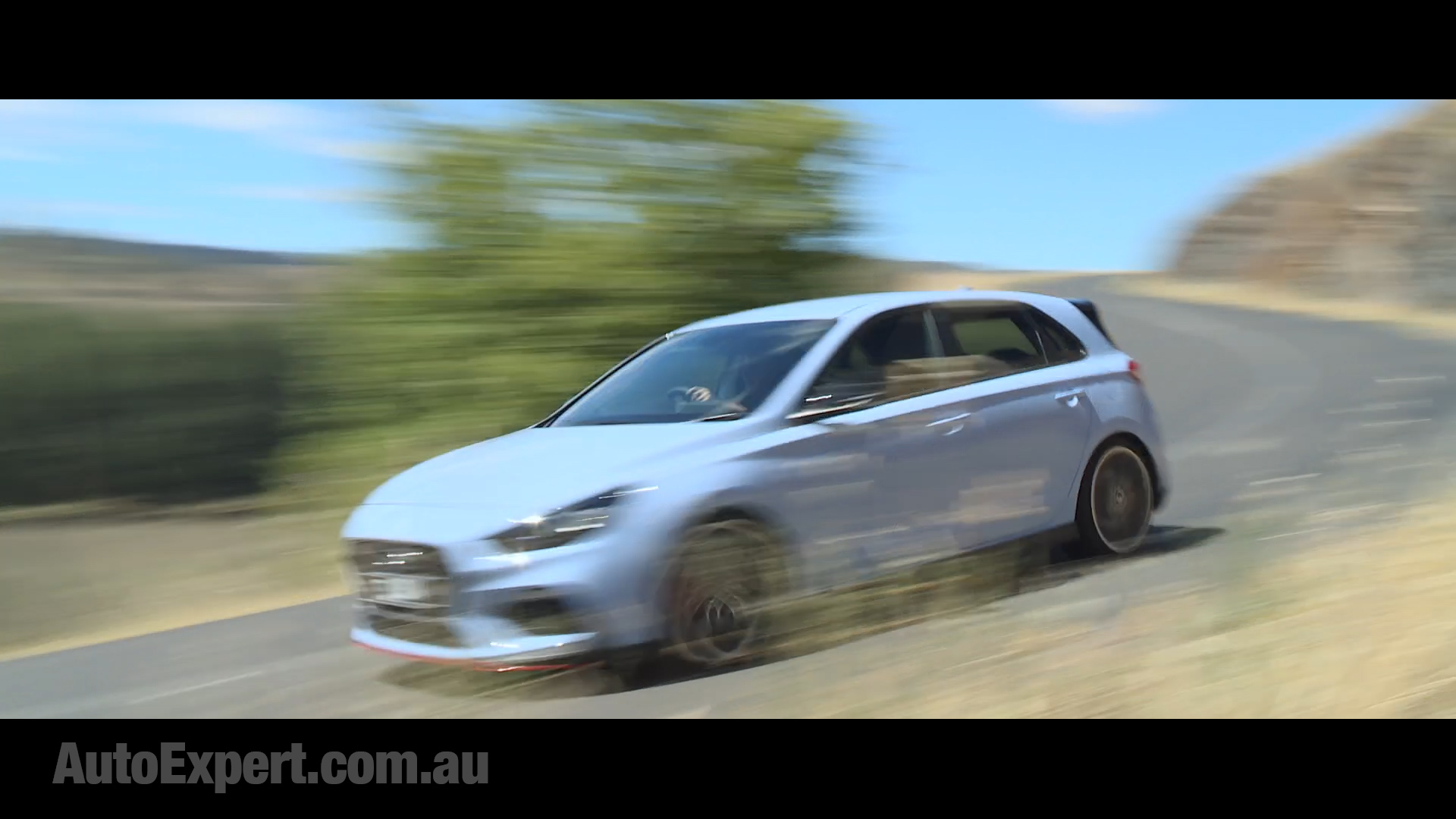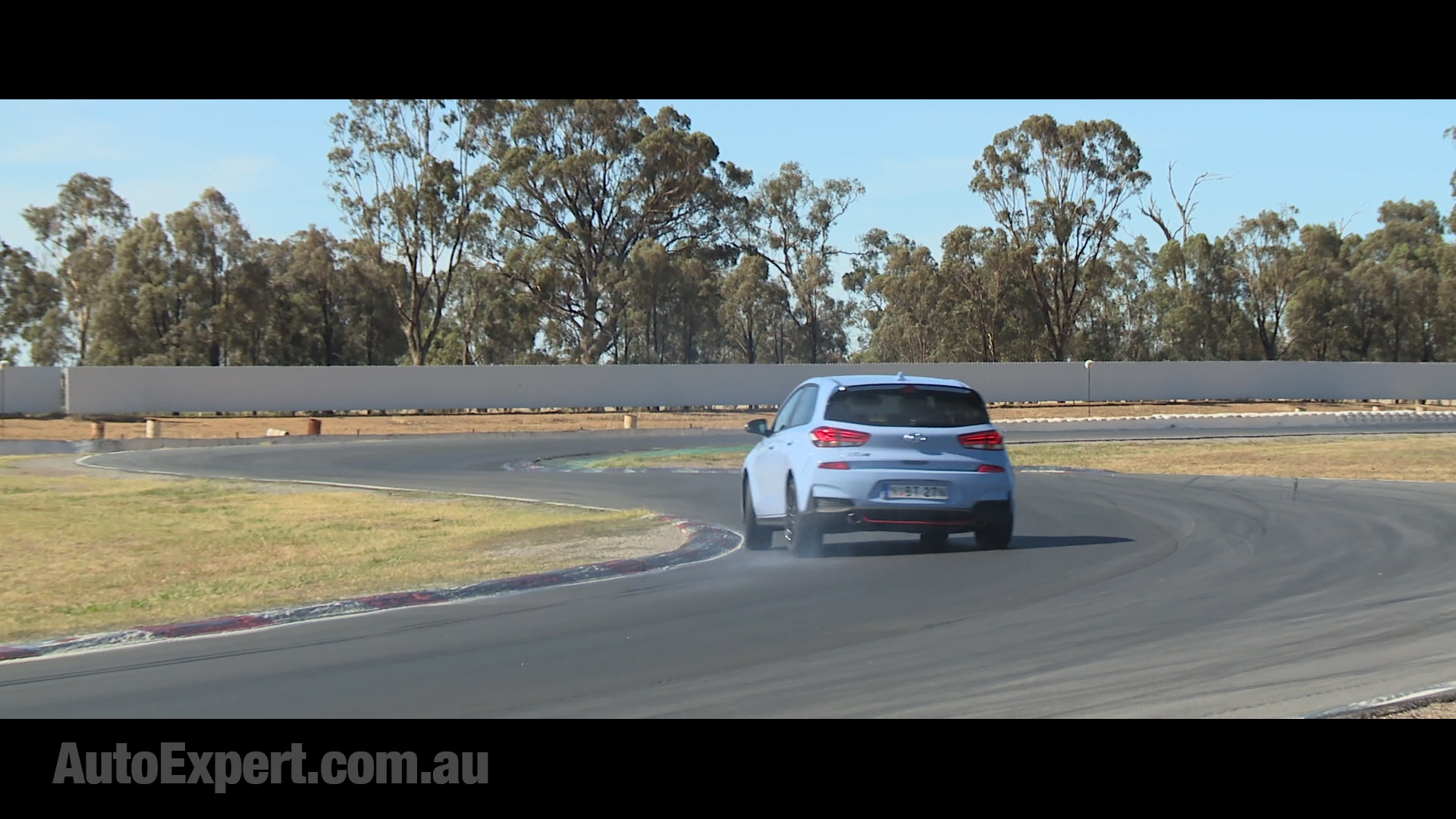Hyundai i30 N review and buyer's guide
On the road or on a track, the VW Golf GTI gets murdered by the Hyundai i30 N not just in performance, but also on value. Bang for your buck is what really matters in this hot hatch cage match.
In this report: The definitive verdict on i30 N’s allegedly un-killable brakes - after 50 kays of hot laps. Did the brakes (or the tyres) go off?
Here's another big question: What about the warranty if you do a similar track test? Even if the car is un-killable, will you void that five-year/unlimited kilometre warranty if you drive your new i30 N like the designers intended?
Plus, can you actually live with an i30 N? You know: because driving's not one long balls-to-the-wall track test. You'll probably also have to use it in traffic just getting from A to B.
But first: what makes the i30 N special? What sets it apart? Let's get into all that.
Points of difference
The i30 N is not some hastily (and cynically) tarted-up i30. It's fundamentally re-engineered.
The i30 N has proper (read: functional) front brake cooling ducts. That’s important. There’s additional structural reinforcement - a transmission tunnel brace and front cross member triangulation. You get electronically selectable multi-mode dampers, the big, fat in-house brakes of which audacious claims are made, a bi-modal exhaust with awesome crackle on over-run (you can turn it off if you want) plus a brilliant limited slip e-diff driven by a high-speed servo motor.
I'll help you save thousands on a new Hyundai i30 N here
Just fill in this form. No more car dealership rip-offs. Greater transparency. Less stress.
There’s a rear strut brace. You get a 2.0-litre force-fed four that out-points the standard Golf GTI, and costs less. Torque and boost indicators - of course - plus one-touch N-mode selection (N for ‘fun’, obviously). Shift light, rev matching, and infinitely customisable everything.
But if you’re looking for an auto or a dual-clutch transmission … move on. Nothing for you to see here. i30 N is six-speed manual only - for now.
This pre-launch test opportunity is very brave. Hyundai’s spanner-spinning Stig, also known as 'Pete', got this car essentially off the ship the day before this report, gave it a once over and a 400km road test and run-in… then handed me the keys. As Colgate famously said: that’s confidence.
So, I guess the least we can do now is see how it actually drives.
On the road
If you’re seriously thinking about buying an i30 N, you’ll probably watch a billion reviews online that talk to you about straight-line performance, lateral grip and braking performance. All of these things are reasonably impressive with this car, but they are not the most impressive thing.
Any Muppet can engineer impressive straight-line performance and grip and brakes and all of that. People do this all day long at the weekend in their garages building up club racers.
The most impressive thing about this car is the integrations of those performance aspects into a package that is so easy and so satisfying to drive.
The really impressive thing about this car is its breadth of capability. You can have your kids or aging parents in the car, neither of which will ever be able to pick up on what this car can really do. When it’s just you and the car, you can flick one little button on the steering wheel and engage the bright red N performance mode, and drive home on your favourite piece of twisty back road in exactly the manner that would have the rugrats hurling their guts out and granny and grandpa hooked up to those machines in intensive care that go beep.
That’s what is so brilliant about this car. It just feels right. It feels right in traffic and it feels right when you’re having a red hot go. In some respects, the harder your red hot go and the more finesse you pump into this car, the more rewarding it is to drive and the more impressive it is.
It’s scary fast if you know what you’re doing.
Trainspotting the i30 N in traffic
If you’re a trainspotter, you’ll be able to spot an i30 N a mile away. Just look for the red piping under the bumper at the front and back of the car. The 19-inch wheels with the Pirelli P Zeros are a bit of a giveaway as well. Plus the high-mount brake light.
If you’re just somebody who doesn’t really care about cars, much like 95 percent of people driving them out there today, this car is going to fly well under the radar. It doesn’t scream “performance animal”. That’s a two-edge kind of marketing sword. If you want a screamingly hot looking performance car – this ain’t it.
But if you want a car to satisfy yourself driving around a bend and fly under the radar, you're in the right place.
Behind the wheel
Some cars are just brilliantly sorted, and you know that because within five minutes of driving it, it feels like your favourite pair of slippers. It is more complex than that though: you can accommodate the control architecture and the feedback straight away.
Then you go into driving mode and you tell the car what to do without a whole lot of analytical thought about what you’re doing with the steering, the throttle and the brakes. This car does that brilliantly. In many ways, the car looks back at you and says: “Is that all you've got? You want to have another crack at that?”
It’s great fun to drive this car on an engaging piece of windy road.
I guess if I had to name one thing I really love about driving the i30 N, it’s the performance once you clip the apex. (You can blame the standard limited slip e-diff for that.)
This is critical for driving enjoyment because the whole complexity of driving is about cornering performance and getting that right. It’s so complex because cornering force is proportional to the square of your velocity, and entry speed is really critical as well. That’s managed by hitting the brakes at the last possible point and washing off, just that 'Goldilocks' amount of speed to get the entry velocity correct into the corner and then you don’t run wide.
You clip the apex and you put the power down and get it on the way out with the steering unwinding. And this is where the e-diff provides 'Superman' grip on the way out. It’s so impressive, it’s hard to describe from the driver’s seat but it’s really easy to feel and once you’ve felt it, you don’t want to go back.
Basically it looks at throttle position, steering position and the body's yaw response, and it transfers torque to the front outside wheel. This is the most heavily loaded wheel (thanks to weight transfer) and it's also the wheel in the best position to keep the car yawing as opposed to pushing wide.
The added grip is phenomenal.
Rev matching for performance downshifts
It’s always nice to make a humbling confession in front of thousands of people, and I have one to make for you now. It concerns the rev matching function that you get with the 'N' drive mode, and which you can set up in the custom menus.
If you're not driving a car with rev matching built in - check out the video below for how to do it the 'old fashioned' way.
I spoke to the Hyundai product guys about this. They were effusive about how well it worked, and I thought: 'Yeah? There's no way it can be better than me at this. If you’re a regular viewer, you’ll know that I’m a heel-toe, gear-changing drill sergeant. I did a whole video on the subject (above).
I’ve done heel-and-toe downshifts for years. I must’ve done a 100,000 of them in total. Without being an egomaniac, I'd like to think I have this particular driving process nailed.
What you do with this car, is jam your foot on the brakes and you downshift the old-fashioned way like any Muppet who’s ever got his manual driver’s license. The computer then reaches into the throttle and blips it at that exact right moment.
And, I hate to tell you, it’s just brilliant. It’s a hell of a lot better than me and it’s a hell of a lot better than you. It's a hell of a lot better than Ayrton Senna would be at it, were he still alive to run that experiment.
Rev matching manages to blip the throttle at that absolute righ moment, and so briefly in the way that you cannot if you’re doing it with the ball of your foot jammed on the brakes and the outside of your foot rolled over onto the throttle.
You versus. computer. Computer:1. You: 0. Conclusion?
Rev matching rocks.
I hate to love it. (And I love to hate it.) But, from a pragmatic standpoint, I'll take it for getting from A to B as fast as possible.
Track endurance
Then there’s the frankly outrageous brake invincibility claims made by Albert Biermann, the big bratwurst of R&D for Hyundai’s N Division (the former BMW M dude).
So, on this, I said to Hyundai: ‘I’m not entirely sure that’s not spectacular horseshit.’
To which they retorted: ‘Yeah? Well, come to our super-secret test track, fang the crap out of it, and see fo’ yo’ self.’
To which I responded: ‘Okay…’
So, I drove 10 hot laps of this very technically demanding (secret) circuit. Each lap involved three big stops - full ABS activation from 160km/h or more and back to second or third, and many other 100km/h+ hard stops as well.
If you have not done this kind of thing, I should point out that you only do three things on a test track:
Accelerate as hard as possible
Brake as hard as possible
Corner as hard as the car can corner
If you're not doing one of those things at any point on the track: 'fail'...
This is (of course) provided that you have the software loaded 'upstairs' to accomplish those things. (If not, you're testing yourself and not the car...)
This kind of driving is entirely unlike driving on the road. It's orders of magnitude harder on both the driver and the car. In particular, the brakes cop a real caning, followed by (in this case) the front tyres. I'm not a race driver - but I know how to play the game at this level. And although I definitely did not set the lap record, I did have a bunch of fun, and the i30 N was operating at 90-95 per cent of its capacity to turn petrol into speed and fun.
Each lap was a little over five kilometres. So I drove the i30 N pretty much 'balls to the wall' for about 50-60 kilometres. As an indication of how hard you go when doing this, I kicked off at the track with about three-quarters of a tank of fuel. At the end of 10 laps, I was down to a quarter, or thereabouts...
This is the kind of driving that 95 per cent of the population just don’t get. It’s about making the machine do what the designer intended, or at least meeting the limits of what the designer intended. If you can do that (if you get the opportunity), it’s incredibly satisfying.
(Partly because in these environments you don’t have to worry about a conversation on the side of the road with some copper about, “what the hell do you think you’re doing mate?”)
So in a nutshell I buttoned of after 10 laps, a ball of sweat. It's quite the workout, physically and mentally. I can tell you from previous experience of many track sessions as a former contributor to Wheels and Motor magazines, where I managed various 'handling olympics' and related track-type tests, that there are very few road cars that you could drive in this manner for ten laps on a really demanding circuit with lots of high speed braking, lots of lateral G, and lots of really high demands on the tyres.
Plenty of allegedly track-capable cars (ones at least marketed that way) would kill the brakes and scrub out the tyres a lot earlier than that. And I can say it's the exact opposite of fun when you jam the brakes on at 160km/h and instead of stopping, the pedal gos straight to the floor because you've boiled the fluid, or the car fails to stop because the pads are on fire. That's not fun.
With the i30 N, after 10 laps at Guantanamo, the brake pedal was as hard as it was when I picked the car up. I drove the car home after that. It felt like I'd just driven it off the showroom floor.
That's bloody impressive.
What do I really think?
Hyundai is the number three carmaker in Australia by sales. They’ve managed to jump on the podium without fielding a performance car, but if they screw this up, there aren’t enough paper towels in the universe to wipe the egg off their faces.
Frankly, however, I see little to no risk of that. The i30 N is through the posts, on the full, from the far end of the field. Volkswagen’s going to have to try from now on. (They’re really gunna hate that...)
The i30 N kills GTI because it offers superior performance at a lower price point. It’s that simple. More grunt for less cash.
Maybe it's not as elegant. Certainly not as minimalist in the styling, no heritage to speak of, and no runs on the board in this domain, but if it’s performance that gets you across the line, objectively, you cannot field a compelling argument for GTI superiority.
The e-diff and the rev matching - brilliant. And it’s very forgiving at the limit. You don’t have to be race-competent to enjoy driving one on a track, but if you are, you’ll love it.
This is an exceptionally rewarding, fun performance car. The ESC - in Sport+ mode - it’s hardly restrictive. It hands you a lot of rope.
(The flipside of all that rope: Like all performance cars, if you’re a Muppet and you crash, it’s not going to be a slow one.)
Obviously, being manual-only, that’s going to turn some people away.
The in-cabin noises are … they’d say ‘enhanced’; I’d say fake. So I was philosophically pre-wired to hate them. But they actually sound pretty good. Certainly, they don’t sound fake - and I guess that’s the acid test of a good fake in every domain: watches, handbags, breasts ... and now in-cabin ambience.
The exhaust crackle from the bimodal exhaust: It serves absolutely no purpose … except that it makes you smile every time. And I guess that’s enough. Maybe that’s just a character flaw…
(I’ll add it to the list.)
Disclaimer
I don’t go to product launches. They’re a complete waste of time. So, Hyundai threw me in that car for a couple of days, early, on the condition that I shut the hell up about it until the launch and the embargo lifted. And they kindly stuck a burlap sack over my head in the manner of Hamas job interview, so I would not know the location of the secret test track.
So that was nice.
But they’re not getting a say in what I say to you in this report, and they’re not paying me for this review. Nor do they advertise with me. So, there’s a church and state separation. You get to know what I really think, and if they don’t like what I say, they can just suck it up.
Is i30 N right for you?
This is a big ‘however’ - I’d stop short of saying the i30 N is a better car than an i30 SR or a Mazda3 SP25 Astina. Better is the wrong word. It’s better if you want a performance car. But if you just want a reasonably sporty car with a bunch of refinement and packed luxury features - the other two are going to be better for you.
In other words, there’s no perfect car, and a lot of the choice is about you. Don’t get talked into an i30 N on the showroom floor, purely on the premise of ‘top of the range equals best’. If you want all the premium features and you’re not gagging to drive around corners on the limit, an i30 SR is going to be better for you. And it’ll save you some cash.
Will your warranty survive?
Finally, the glace cherry on the icing on the cake of the Golf GTI’s funeral is this:
It’s cool to review cars. It’s cool to be given exclusive access to a racetrack when a carmaker wants to prove a point.
At the media launch in Australia, Hyundai hired the Winton race circuit and invited the press to drive really really fast, and not crash.
It’s generally a meaningless stunt when carmakers do this. Because the minute you do this, as an owner, you void the warranty.
In researching this aspect of the report I’ve been told several car companies in Australia enthusiastically monitor Facebook and other social mediums solely for the purpose of compiling a database of track users. This data is then used to deny warranty claims. And to me, it seems unethical to release a car with track-type aspirations, and market those aspirations to get you across the line, and then operate in this way, under the radar. In short, it’s a mongrel act.
Hyundai tells me - in writing - that if you take your i30 N to a track, your warranty will survive. Hyundai says as long as it’s a non-competition event (I take 'competition event' to mean a time trial or race, broadly) then, Hyundai says, there will not be a Spanish Inquisition on a warranty claim following you driving it like you stole it, for kicks, in a safe, controlled environment, which (as you’ve seen) can be quite therapeutic.
They tell me they will even honour the warranty if you put a set of track performance-oriented tyres on the car, for even more grippy goodness. Try getting a commitment like that out of Volkswagen.
Conclusion
Best thing about the i30 N is you can drive it to the track, blow out the cobwebs (its and yours) without breaking it, emerge like an inverted James Bond martini (stirred but not shaken) and drive it home - without carrying a trailer full of spare parts, or even touching a spanner.
If you’re the kind of sick, twisted deviant who enjoys that kind of thing, I feel your pain.
What a terrible affliction.




















































